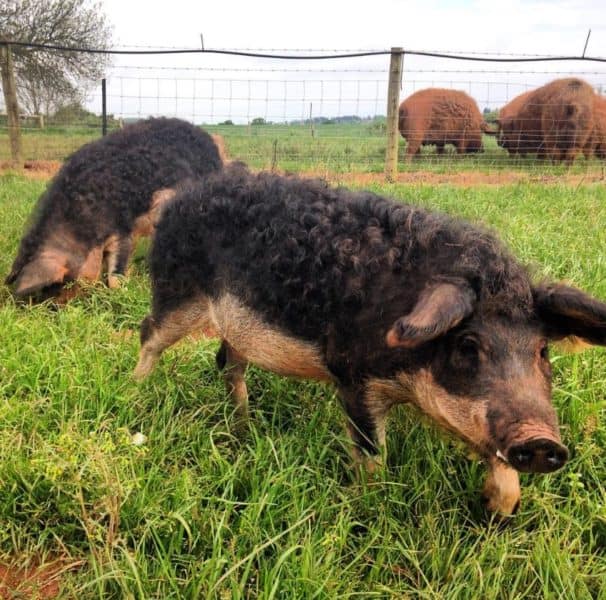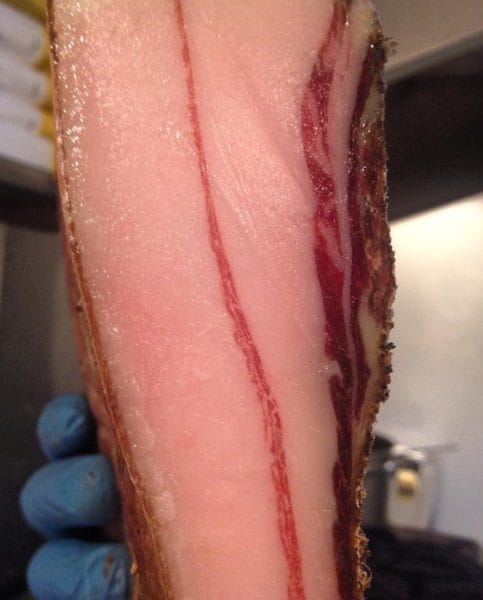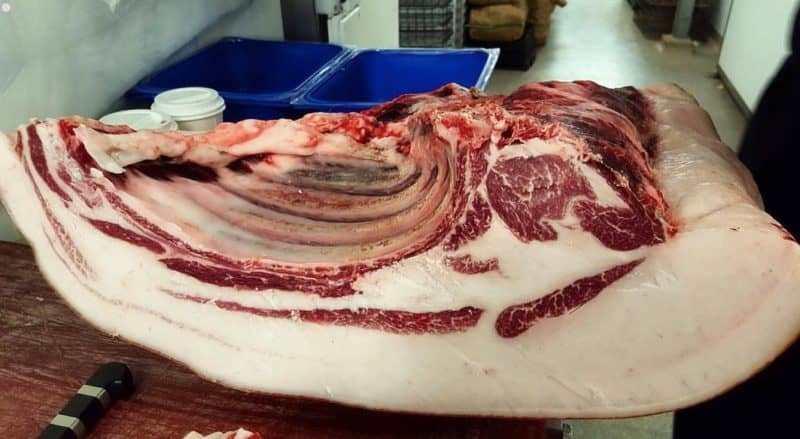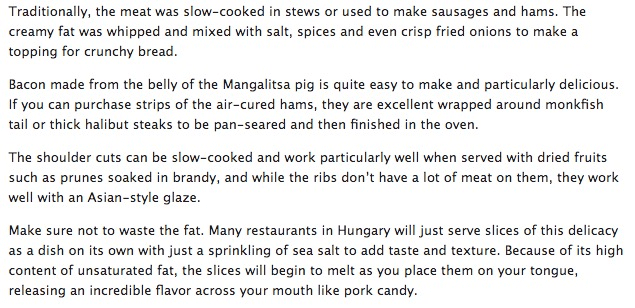“Crisply braised,
A paragon of fat and lean
Drips juicily upon the pit.
Sustainer of the South,
The Pig doth yearn to
Sacrifice and serve.
I eat it lustily,
Sauce-stained and smiling.” Anonymous.
Just before I do more on Spain & Japan (as I earlier promised I would), I’ve been distracted prompted to write another brief reminder of these lovely creatures both by the description of the fat on the Jamón ibérico from the pata negra and by a number of Mangalitsa breeders (& enthusiasts) on Instagram and Twitter.
Among these enthusiasts is Tom Adams of Coombes Head Farm in Cornwall who turns the meat from his Swallow-bellied and Red breeds…

…into this gorgeous speck…


James Villas says — and who am I to disagree — that vegetarians and those that do not eat pork for religious reasons are “haunted instinctively by the sensuous, irresistible enticement”.¹ They’ve a distinctive, strong taste that the French would likely call rassé (by the way, that’s a word that you shouldn’t use in front of your maiden aunt). And if any pig is worthy of the description “a full, sapid flavour” — I love that word — it’s the Mangalitsa, a beast that is, sadly for them, out of the reach of these religious maniacs. But that’s OK; as I’ve said before, that leaves more for the sensible rest of us.
I’ve written long pieces and eulogies to this animal before, here and here, so when you’ve finished here, you can wander off to get your fix of more in-depth background.
So, today, just a quick recap on these Hungarian pigs (called there, Mangalica, which means “pig with a lot of lard”). I can vouch for that fa(c)t; and you only have to look at that last shot above, to know that, if anything, they’re more well endowed with fat than even their Iberian cousins to whom they’re genetically very similar. And, just like them, Mangalitsa are prized for the fat that it produces, low in (“bad”) saturates and high in (“good”) oleic acid. So much so, that at one time, their meat was reserved for supply only to the Hungarian royal family and later they were traded on the Vienna stock exchange alongside gold. In Budapest now, there’s an annual mangalitza festival held in February which sees Hungarians descend on the city to pay tribute to this special livestock..
First bred in the early part of the 19th century — at the request of Archduke Joseph — their meat remained in high demand right up until the mid-20th century with the country’s new Communist government (not alone here, as so many non-Communist governments around Europe also went down that same road) mandating a move to farming leaner animals that could produce more meat, more rapidly as everyone was now officially ‘poor’. The Mangalitsa pig went into a rapid decline, almost died out, but since then recent efforts have revived its popularity and Hungarian farmers now produce more than 70-80,000 animals a year. This good word has spread to England and the USA, helped in no small measure by early encouragement from chefs such as Thomas Keller at “The French Laundry” and later Atera and Veritas in New York
The important thing as always, to make sure they don’t die out, is to eat them. So here are some ideas on how to use this lovely animal, presented by Rotherham born (but now US resident) Simon Majumdar ²
And finally, a shout-out via some links to the other Mangalitsa breeders from earlier; I’d strongly encourage you to follow them. And obviously (durr!) to buy their meat to encourage them in their endeavours!
“Royal Mangalistsa” from Holland, then Yorkshire Mangalitsa from, well, Yorkshire and lastly (in English, the Welsh, Mynyddmawrherd, hurts my tongue) Welsh Mangalitsa.
And finally, finally, there’s apparently a sludge metal band called Mangalista. Who knew? And who knew that this was even a genre? I’m getting old…
Ref:
¹ The Bacon Cookbook. (2007) by James Villas

